At 0400 on July 16 the first half of our Atlantic crossing was completed with our landfall at Lajes on Flores Island in the Azores (published May 2016)
We were contemplating entering the breakwater and anchoring in the dark, something we’re normally reluctant to do. Tipping our decision toward anchoring in the dark was that before departing Victoria, BC at the beginning of a series of passages to Sweden, we had downloaded the latest updates for C-Map charts and had been surprised at the level of detail provided. Additionally, we had the radar and AIS overlaid on Navionics charts running on our Raymarine MFD and had twice previously anchored there so we decided to proceed to the anchorage, but not into the small new marina.
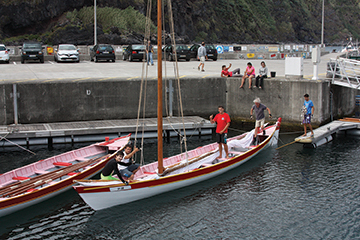
Although we’d viewed the new marina tucked behind the recently-extended breakwater on Google Earth, we decided that attempting to enter it in the dark would be unwise, so we dropped anchor in 20 feet halfway between an anchored cruising yacht near the cliff and the breakwater which also serves as the island’s commercial wharf. We were excited but tired and before retiring we celebrated our arrival with a hot cup tea and cookies and rigged our second anchor light; a blue LED light suspended from the boom above the hardtop dodger.
ISLAND EXPLORATION
At first light, when I peeked through the aft cabin’s curtains, I thought I was seeing a ghost ship. Off in the distance, occasionally visible through the misty early morning light, a frigate was steaming back and forth across the harbor entrance. I awoke again at 0730 to a low rumble and there was indeed a naval frigate but now it was bearing down on us, obviously heading for the wharf. I leapt out of bed, bounded into the cockpit, quickly starting the engine and with the anchor still down, reversed Mahina Tiare away from the wharf to make more room for the frigate to maneuver alongside. I was keen to check out the new marina so we launched our RIB. Heading into the inner basin, I discovered an ideal situation—the end of one of the dock had a 60 foot berth available. A fisherman who had watched me entering the harbor motioned that it would be fine to moor Mahina Tiare alongside.
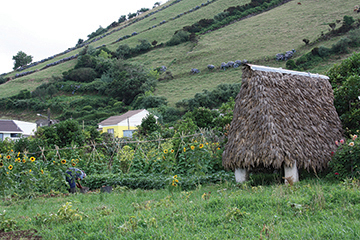
Jose (one of our expedition members originally from the Azores) came with me to the harbormaster who proved to be the most efficient one I’ve met. Harbormaster Tiago Pimental, (email: marinaflores@portosdoacores.pt) acted like a one-man island promoter. When I mentioned we were all keen to explore the island, he quickly pulled up details on his computer then printed off and explained a spectacular hike within walking distance from the port that traverses a cliff face to a wild and isolated beach. I also commented on a sign located at the marina gangway and Tiago said that Silvio Medina of Tours of Flores (www.toursofflores.com, email: toursofflores@gmail.com) does an excellent job of showing visiting yachties around the island and that he has two nine passenger vans. Tiago proceeded to call Silvio, passed his phone on to me and I made a booking for a half-day tour for 20€ each.

Tiago then entered all of our boat and passport information into his computer as Jose (in Portugese) and I (in English) peppered him with further questions. After a few minutes he printed out and emailed us entrance and exit clearance forms. He also advised us that all of the information would be available to the harbormaster in Horta, so entrance there should be quick and easy. Tiago said the new marina was mostly paid for (like seemingly all the infrastructure in the Azores) by the EU and had proved very popular with over 150 boats visiting annually. Showers, internet, electricity and water are all included for the amazingly reasonable price of 18€ per night, the least we’ve ever paid for moorage, anywhere.
When asking about the island’s population, Tiago said that the current count of 3,600 included the many people who’d long ago immigrated to the States and those who’d also passed away. He said the young people (he looked to be around 40) continue to leave for brighter lights but we sensed that Tiago had a strong love and connection to the island. Although his parents had immigrated to Lisbon, he’d chosen to return.
Our crew were excited! After showers and with Jose using Tiago’s directions they headed off on what turned out to be a very challenging cliff to sea hike while Amanda and I hitchhiked 15 km in the opposite direction to check out the amazing new whaling museum in Santa Cruz, the island’s largest town.
That afternoon in the harbor, the two traditional Azorean whaling boats were boarded by a group of kids and adults who promptly got them ready for sailing. Built for the whaling industry, these historic boats are now used for racing under sail and oar. Whaling was an important part of the Azores economy until 1981. Whales were spotted by lookouts high on the island who then fired signal rockets, alerting the farmers to head for the boat ramps. Although powered launches were used to tow the whale boats out to the whales the whale hunting was only done under sail or oar. After a capture the launches then towed the whales to shore-based rendering plants.

In the evening we all met at a restaurant overlooking the 1910 lighthouse and harbor for a typically huge Portuguese fish dinner. David had met the town mayor who promptly invited our crew to opening ceremony of the annual Festival of the Immigrants at the new civic hall. This year Lajes was also celebrating its 500th anniversary. Not having a clue of what to expect, four of us decided to attend. After listening to many speeches in Portuguese, a musical group from Boston composed of seven stringed instruments, an accordion player plus three folk singers put on an amazing performance of Azorean folk songs.
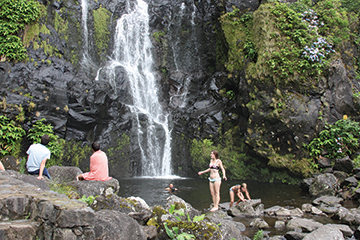
The next day after a morning run to the cash and carry for fresh provisions of local pineapple, melons and hot corn bread, Silvio Medina (www.toursofflores.com, toursofflores@gmail.com) picked us up at the harbor. What followed was a stunning tour of this very rugged island where we got to check out all the best possible anchorage and harbor options (very few!) Silvo delighted in telling us the history of each village and what they were structured around. The best of all was returning to Faja Grande, literally at the end of the road on the west side, where stormy conditions in Lajes had forced us to seek shelter in 2000.There is now a new stone-paved walkway past an historic water-powered grain mill to a large natural swimming pool underneath the island’s tallest waterfall.
Silvio saved another real treat for last. Just two kilometers from Faja Grande is Aldeiada Cuada www.aldeiadacuada.com, an old village of 16 abandoned farm houses that have been restored. The village was abandoned in the 1960’s when its inhabitants emigrated to the US and a person from Horta purchased, restored and now rents out the homes as guest houses. We looked into one of the homes that serves as the front desk/registration area, and it was like entering an historical museum.
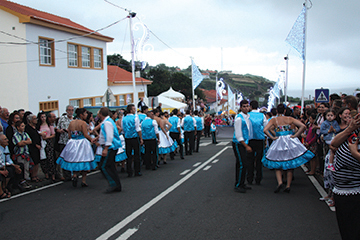
That evening our crew had dinner at the festival food tents where Jose got them to try several local specialties including octopus. Earlier in the day the ferry from Horta arrived for the first time this year bringing several hundred visitors and it was obvious everyone was very proud of their culture and tradition. At sunset the parade started down the long main street towards the harbor although it was short on numbers this year as there hadn’t been enough funds to cover transportation of additional bands and dancers from other islands as in the past. So when the band from Fajazinha finished providing the accompaniment for a very exuberant folk dancing group they rushed back to the top of the hill to accompany the dancers that followed the school dancers and band. Along with the parade it was interesting to watch the crowds. Out of at least a thousand people, no one appeared drunk or rude, there was no visible police presence, small children wandered about with everyone greeting them and keeping an eye on them and everyone was enjoying the evening. We were invited to a symphonic concert in the park to be held at midnight, but headed back to the harbor, exhausted.
Not wanting to arrive before dawn at Horta, our next port on Faial Island we waited until 1100 before setting sail on the 135 mile passage. As we sailed away from Flores the sun came out on the rugged island and the string of red-roofed whitewashed stone houses stretching along the cliffs looked like doll houses. Waterfalls tumbled down the cliffs and mist covered the jagged peaks and it looked and felt as if we were leaving Shangri-La.
After a smooth overnight passage, we were treated to an excellent sunrise on our arrival at the island of Faial. Upon entering Horta harbor there were tons of local kids in Optis and Lasers zipping around as part of the yacht club’s summer sailing program. Our check-in at the harbor office was a cinch, thanks to Tiago’s having already forwarded all of our information. In no time we were assigned a berth rafted one out from a catamaran on the breakwater wall. It was a treat being back in Horta, catching up with old friends and finding the painted boat names of Maiden Great Britain (Amanda’s Whitbread Race boat), Taitoa (Amanda’s parent’s wooden gaff ketch from their 1988 visit) and Mahina Tiare’s still amidst the hundreds of boat names and paintings on the breakwater and marina walls and sidewalks. But after two nights in port, the crew departed and Amanda and I set sail for Pico Island.

On our first date in 1994 in Auckland, NZ, I asked Amanda, whom I’d only just met in a rigging shop while preparing to sail to my Hallberg-Rassy 42 to Cape Horn and Antarctica, if she’d ever sailed before. “A little” was her answer. I then asked if she had a favorite place to sail. When she answered the Azores, I was impressed. A few days later she’d moved aboard and we’d set sail for Cape Horn, via Tahiti. Six years later we sailed to the Azores, and it was such a charming visit that I vowed to return. We did so in 2006 and took our folding bikes on the ferry from Horta to neighboring Pico Island, circumnavigating it’s 60 mountainous miles in two days.
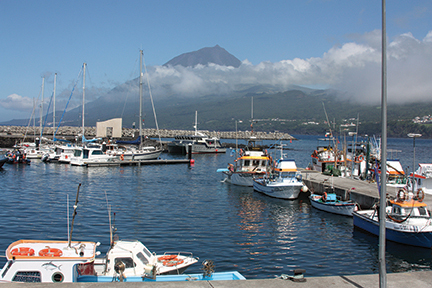
On our earlier cycling adventure, we were especially attracted to Lajes and Ribeira, two small whaling/fishing villages that looked like possible anchorages. While clearing out with the Horta harbormaster, I asked him to call and see if there was room for MT in the Lajes marina—there was, and when we arrived, the harbormaster and his assistant helped us into a small slip. I wanted to check out a small new marina 22 miles away in Lajes on the south side of Pico Island.
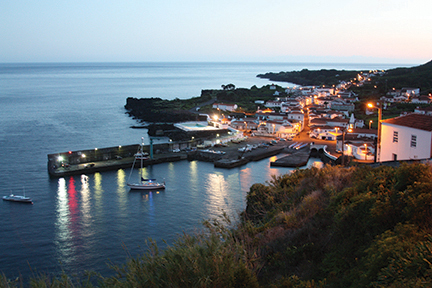
In days of whaling, Lajes do Pico was a very busy and thriving town. Whales are now hunted with cameras instead of harpoons and in Lajes’ small harbor we counted eight 20 passenger inflatable whale watching boats which each went out three to four times a day.
RIBEIRAS
Between working on boat projects we spent our time exploring town and as part of an extended morning run we hitchhiked 10 kilometers south to the smaller whaling village of Ribeiras. The village looked like a postcard with four immaculate whale boats, the town’s current race fleet, pulled up on the boat ramp and what appeared to be nearly enough room to anchor MT out of the swell behind the breakwater. As soon as we hitched back to Lajes we paid our moorage bill and set sail for Ribeiras.
Ribeiras harbor is tiny, and their historic whaling motor launch is moored in the prime spot. We ended up mooring inside the breakwater by dropping our main anchor in the only sandy spot and using the dinghy to position an opposing bow anchor 180 degrees apart (Bahamian mooring). This technique allowed MT to swing around into frequently-changing wind in a small radius without coming too close to the rocks, wharf, or whaling launch.
This worked perfectly for several days and we had a blast, snorkeling, trail running to explore the coast, checking out the village and hitchhiking further down the coast to Nesquim, an even smaller whaling village. Most of our rides were with farmers, and even if they spoke only Portuguese, they were very hospitable even though we frequently couldn’t understand them. Before we knew it, it was time to head back to Horta to pick up our next expedition crew and set sail for Ireland. We arrived early Wednesday morning in time for grocery shopping and for Amanda to spend the following day touching up the paint work on the three boat names on the marina wall.
While hurrying back from our final grocery shop to welcome our crew at noon on Friday in the marina we passed an entourage of VIP’s that looked like the mayor, head of the navy and other dignitaries, all carrying colorful printed bags with hydrangeas sticking out of the top. When we got back to MT, we found one of the bags and the guy on the next boat said we’d just missed the town officials personally inviting all visiting cruisers to a cocktail party that night at the yacht club to kick off the 40th Semana do Mar, or Sea Week; a festival of sailboat and whale boat races, rowing races, music, parades and a food festival. In the bag was a booklet about the festival events, a letter in Portuguese, English and French inviting all yachties to dress their yachts with all the flags they had plus a big slab of vacuum-packed local gourmet cheese. Unfortunately, we were just about to set sail, but it sure would have been fun to join in the festivities.
As soon as our next crew stepped aboard we enjoyed a quick lunch before setting sail on a glorious sunny downwind sail for Velas, Sao Jorge Island, 22 miles to the north and the site of another new marina.
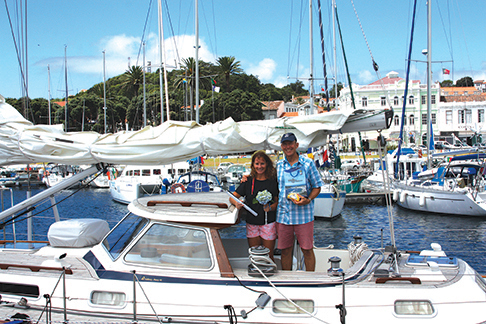
We’d been hearing stories of the legendary hospitality of Jose Dias, harbormaster at the recently completed Velas Marina and sure enough, Jose was on the end of the first dock, waving us to the one remaining end-tie large enough for Mahina Tiare. He warmly welcomed us to his island and was genuinely sorry to hear we planned to spend only one night. He suggested an amazing restaurant for dinner and that perhaps we might enjoy the community lava rock ocean swimming pool a short walk away. We were delighted to take him up on both suggestions.
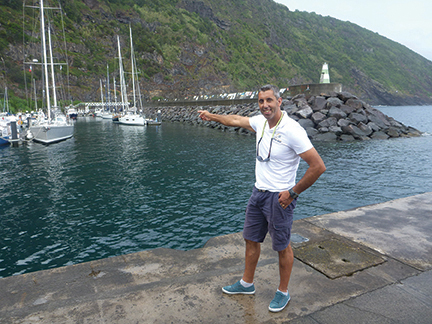
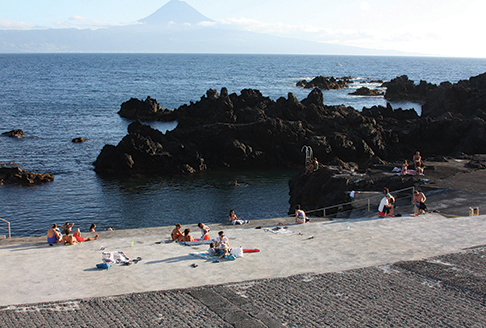
Velas is an attractive little town with interesting and unusual architecture, parks and civic buildings and very friendly inhabitants so it was hard and sad to leave but we were hoping to make the 1100-mile passage to Ireland between two very powerful storm systems tracking across the North Atlantic.
We’re already planning our next visit to the Azores, possibly with backpacks and our folding bikes!
Since 1976, John’s passion has been sharing his knowledge of ocean cruising and he has conducted more than 170 sail-training expeditions worldwide along with his wife Amanda Swan Neal, aboard their Hallberg-Rassy, Mahina Tiare III.

















